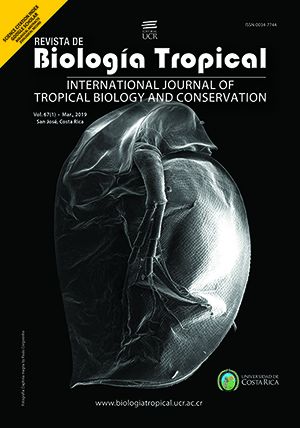Resumen
Los mosquitos (Diptera: Culicidae) son importantes vectores de diversos organismos patógenos, tales como arbovirus y protozoos. Los estadios inmaduros de los mosquitos pueden encontrarse en un amplio abanico de hábitats, tanto de origen natural como humano. Algunos lugares antrópicos, como los cementerios, sirven como prósperos hábitats artificiales para el desarrollo del ciclo de vida de los mosquitos. A pesar de constituir importantes focos para especies de interés vectorial, los cementerios urbanos son frecuentemente olvidados en los programas de vigilancia y control. Este estudio evaluó la asociación de algunas variables ecológicas (tipo de material, presencia de flores, disponibilidad de agua, y altura respecto al suelo) de los lugares de cría (recipientes) con los niveles de infestación de las fases preimarginales de los culícidos. En 2017, un cementerio urbano en Jarabacoa (República Dominicana) fue inspeccionado durante dos periodos climáticos (marzo: estación seca y agosto: estación húmeda) para caracterizar los lugares de cría artificiales, captura de los estadios inmaduros de culícidos e identificación de los adultos emergidos a partir de las fases inmaduras. En total, 968 recipientes fueron examinados, conteniendo 7 758 inmaduros en 203 (21.0 %) recipientes con agua pertenecientes a cuatro especies, Culex quinquefasciatus (50.5 %), Aedes aegypti (47.1 %), Aedes albopictus (1.9 %) y Culex nigripalpus (0.4 %). El índice de recipiente (IR) fue del 20.9 %, y los recipientes fabricados a partir de roca (cemento, cerámica y barro) y plástico tuvieron el mayor IR = 25.9 y 23.4 %, respectivamente. Casi un 95 % de los recipientes con agua infectados estaban constituidos de materiales tipo plástico o roca. No se encontró asociación entre el tipo de material del recipiente y la densidad. En general, mayor densidad de estadios inmaduros fue observada a nivel del suelo que a alturas mayores. Se observó un incremento significativo del número de C. quinquefasciatus en recipientes con flores y grandes volúmenes de agua. Por el contrario, los estadios de A. aegypti fueron más frecuentes en recipientes sin flores. Como reflejo de su comportamiento oportunista y amplia plasticidad ecológica, los mosquitos Culex y Aedes fueron abundantes en los cementerios, siendo capaces de desarrollar su ciclo de vida acuático en cualquier tipo de recipiente, con independencia del material que lo constituye. Nuestro estudio, por tanto, mostró que algunas variables ecológicas tienen un impacto crítico sobre el desarrollo de los estadios inmaduros de algunas especies de mosquitos. Tanto las autoridades de salud pública como los cuidadores del cementerio pueden beneficiare de estos resultados centrándose en la implementación de planes detallados y estrategias integradoras para el control y prevención de mosquitos que infectan cementerios.
##plugins.facebook.comentarios##

Esta obra está bajo una licencia internacional Creative Commons Atribución 4.0.
Derechos de autor 2019 Mikel A. González, María Altagracia Rodríguez Sosa, Yohan Enmanuel Vásquez Bautista, Lorenzo Diéguez Fernández, Miguel Borge de Prada, Kelvin A. Guerrero, Pedro María Alarcón-Elbal


